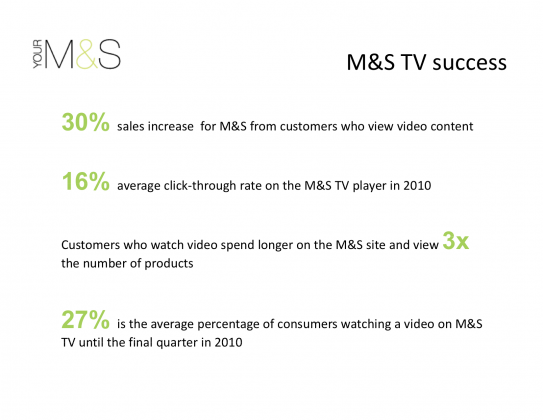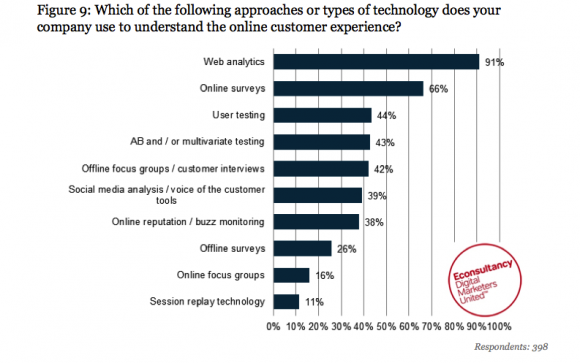Regarding the UI, log onto Gmail and go the Settings page. What you see below is just the first of 13 settings tabs. How does a normal human manage such complexity? Google’s engineering culture has made it the large-scale computing king, but these computer scientists don’t seem to have a feel for what lesser mortals experience.
Archives for June 2011
Wyrwane z kontekstu – Google’s SOE Strategy of Everything
UX Storytellers – na Kindle i w formacie EPUB
UX Storytellers, książka o której pisałem jakiś czas temu doczekała się wreszcie swojej wersji w formacie EPUB i MOBI. Polecam, bo naprawdę jest godna przeczytania.
Można ją pobrać za darmo stronie autorów lub lokalnie:
Grafika – Most common/serious issues of company website
Źródło: Wyniki ankiety przeprowadzonej na grupie 334 badanych, raport Reducing Customer Struggle, Econsultancy + Tealeaf
Wyrwane z kontekstu – The Secret Lives of Links
The only text more useless than “learn more” is “click here”.
Święta prawda. Więcej? ;)
Źródło: (z prezentacji) The Secret Lives of Links, Jared Spool, An Event Apart 2011 Atlanta
Wyrwane z kontekstu – Eye Tracking Without Eyes
But even based on me just eyeballing the results, I know I wouldn’t be comfortable making decisions based on the computer-generated predictions. (…)
Computer-generated visualizations of human attention may work better for pages with no scrolling and under the assumption that users will be completely unfamiliar with the website and have no task/goal in mind when visiting it. How common is this scenario? Not nearly as common as the sellers of participant-free eye tracking would like us to believe.
Źródło: Eye Tracking the User Experience: Eye Tracking Without Eyes, Aga Bojko, Rosenfeld Media Blogs
Grafika – M&S TV success
Źródło: (prezentacja) Online Video: Simon Wood, Head of Operations, Marks and Spencer
Wyrwane z kontekstu – Wireframes
I would almost say never trust a user experience consultant that delivers perfect wireframes. During the process of many projects, wireframes are used as communication tools and should never match the finished product. The real judge of a user experience consultant is the final result: how did the client benefit. If the consultant can’t answer this, shiny is useless.
Źródło: The Top Six Indications You Need A New User Experience Expert, Usability Counts
Prezentując tego typu prototypy klientowi zauważyłem jednak, że moja konkurencja wygrywa ze mną prezentując bardzo podobne projekty, ale w większym stopniu wykończone graficznie i tekstowo. Teraz mogą się podnieść głosy, że nie potrafiłem przekonać klienta do idei prototypu, być może, ale prawda jest taka, że czarno – biały prototyp nie był tak atrakcyjny sprzedażowo jak jago konkurent lepiej wykończony graficznie.
Źródło: Rola projektanta interakcji w projektowaniu serwisów WWW, ucd.com.pl
Grafika – Methods used for understanding the customer experience
Źródło: Wyniki ankiety przeprowadzonej na grupie 398 badanych, raport Reducing Customer Struggle, Econsultancy + Tealeaf
Wyrwane z kontekstu – Examining Repetition in User Search Behavior
Many queries and URL clicks are repeated over time. Users show both seven day and 24 hour periodicities in their use of search engines and these periods repeat and stay consistent over many weeks. Use of search engines is also bursty with users tending to repeatedly use search engines within a short period of time (e.g. a few weeks).
Źródło: Examining Repetition in User Search Behavior, Mark Sanderson and Susan Dumais, ECIR’07 Proceedings of the 29th European conference on IR research
Wyrwane z kontekstu – Capturing What You’re Not Implementing
Most organizations have a method for documenting the UX specifications for a project. These documentation methods usually focus on what is to be included in the project. As you and your team continue to iterate on the specifications through the life of the project, some ideas will be removed. For example, an entire use-case description might be determined to not be significant enough to be accounted for in the project, so the concepts related to that use-case are “scoped out” of the project. However, don’t discard the related artifacts that have been already generated. Those ideas, though not implemented in the current project, could be a viable solution for another future project.
Źródło: Capturing What You’re Not Implementing, Frank Garofalo, UX Magazine
Wyrwane z kontekstu – Does Translation Mean You Should Omit Illustrations?
One hunch I have about Ikea’s visual technique is that they use a lot of small pictures in sequence, rather than several large diagrams (see this example).
In the Ikea model, you see about 20 smaller pictures to follow, rather than one or two large diagram-like pictures. Why? Without words, you’re forced to simplify the process you’re representing. The way you simplify an image is by breaking it into smaller images.
Perhaps the way to incorporate illustrations in documents that require translation is to chunk up the illustrations into simpler images that almost anyone can follow. You may end up with more images, but as a whole the images in sequence can help tell the same story that the single image would tell. (Note: I’m referring to illustrations, not screenshots.)
Źródło:Does Translation Mean You Should Omit Illustrations?, Tom Johnson, I’d Rather Be Writing
Wyrwane z kontekstu – Why I can’t convince executives to invest in UX
I’ve been pitching our services for 23 years and I’ve never once successfully convinced an executive of anything (…)
Have you ever met a smoker? Of course you have. Have you ever met a smoker who didn’t know the harmful effects of smoking? I bet not. Every smoker I know is well aware of what smoking does to their bodies, yet they continue to smoke. There are physical, cultural, and behavioral forces that make it hard to quit.
You can’t convince a smoker to quit smoking. They need to just decide they’ll do it. On their own. When they are ready. It’s the same with executives. Neither I, you, nor anybody else can convince an executive to invest in user experience. (…)
Źródło Why I can’t convince executives to invest in UX (and neither can you), Jared Spool, UIE Brain Sparks








Recent Comments